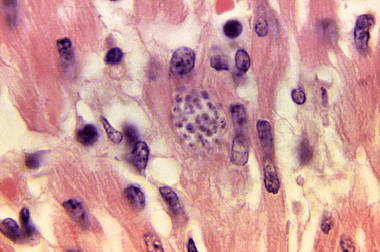Infectious diseases >>>> Histoplasmosis
Histoplasmosis.

Disease histoplasmosis refers to fungal aerogenic infections. The causative agent of histoplasmlosis Histoplasma capsulatum lives in the soil enriched with feces, on the remains of dead animals and plants. The mushroom is quite resistant to temperature fluctuations, in a dry environment spores are stored for up to four years, there are strains of the fungus that can withstand boiling at 60 oC. Infection of animals and humans occurs at the time of inhalation of the spores of the fungus. Spreading through the respiratory system, spores enter the alveoli, germinate and form granulomatous foci in the lungs. Part of the conidia of the fungus is captured by macrophages and carried with the blood throughout the body. If various organs are affected, then they speak of a disseminated form of histoplasmosis (this is a fatal form of the disease). But most often lung tissue suffers and a severe form of pneumonia develops.
Factors of infection with histoplasmosis.
The fungus Histoplasma capsulatum is found everywhere, usually in the habitat of birds and rodents. Most often, workers in poultry farms, agricultural storage facilities, miners, road workers and construction workers, and rural residents are exposed to histoplasmosis. The most vulnerable to infection are children, the elderly and people with weakened immunity.

Histoplasmosis – signs.
A characteristic feature of the disease is histoplasmosis is its tendency to a latent course (asymptomatic). When going beyond the asymptomatic course of the disease, histoplasmosis makes itself felt with signs that resemble the symptoms of SARS. X-ray reveals foci of parenchymal lesions of the lung tissue, resembling tuberculous lesions. Sometimes with histoplasmosis, a large accumulation of infiltrate is formed in a certain place of the lung tissue - histoplasmoma, which is indistinguishable from lung cancer on an x-ray. To clarify the diagnosis of histoplasmosis, laboratory tests of sputum are performed for the presence of the fungus Histoplasma capsulatum.
Cases of an acute course of histoplasmosis are known, manifesting as a respiratory disease and ending with recovery after two weeks. But most often with histoplasmosis, a chronic course of the disease is observed, which lasts from several months to a year.
Histoplasmosis - treatment.
To construct the correct treatment for histoplasmosis, its differential diagnosis is required with a number of diseases: tuberculosis, bacterial or viral pneumonia, pneumoconiosis, sepsis.
Treatment includes the antifungal drug Amphotericin B, Itraconazole, Ketoconazole, Fluconazole. The choice of the drug depends on the severity of the course of the disease. Supportive immunotherapy, antihistamine therapy, vitamin therapy are carried out (but one should take into account the fact that the mushroom is not indifferent to B vitamins, and their presence favorably affects its vital functions), if necessary, corticosteroids are used to relieve inflammatory processes. Blood transfusion is performed.
Treatment of the pulmonary form with timely medical attention is successful, disseminated forms of histoplasmosis are often fatal.

Read

Read



























